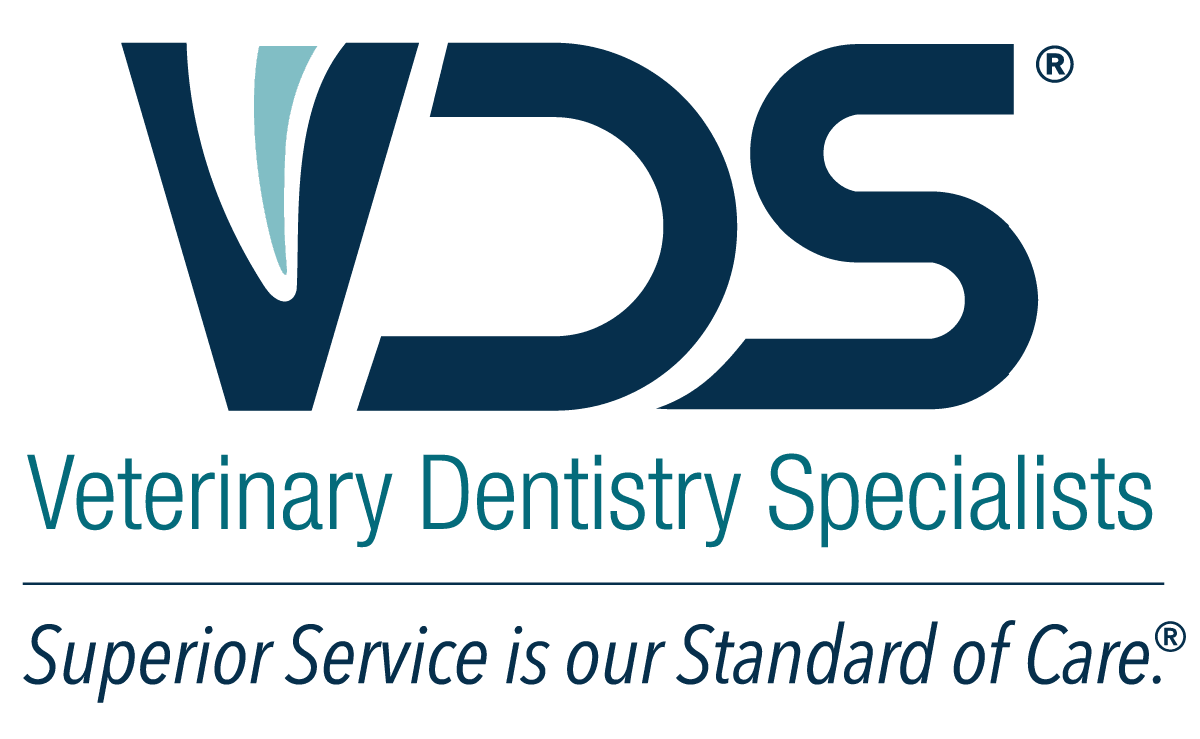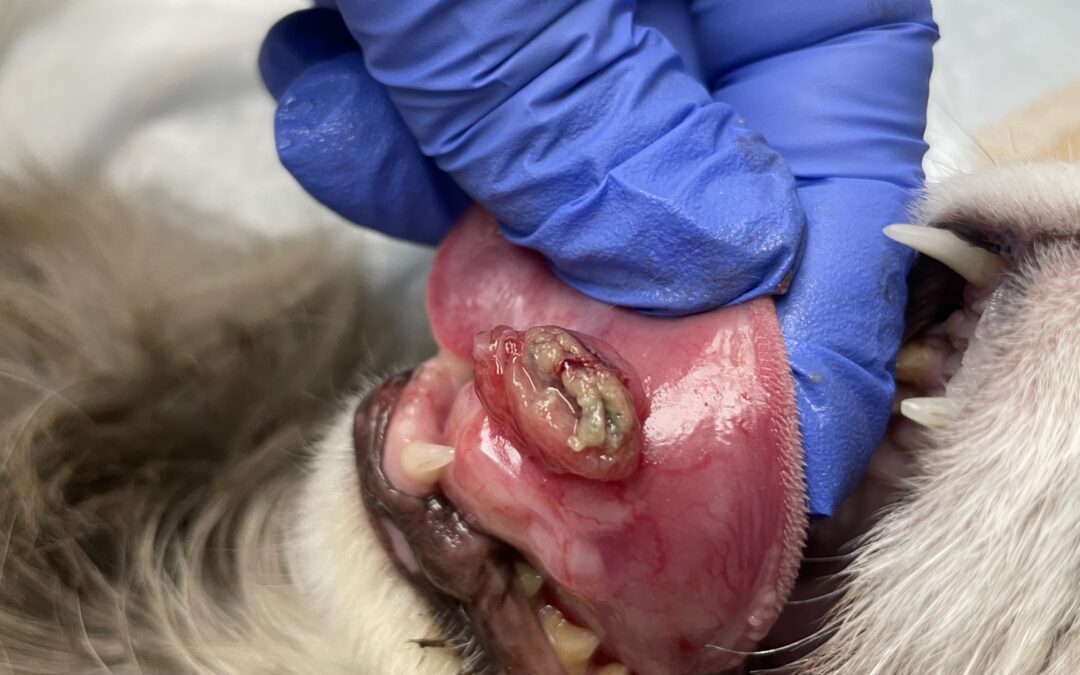Finding an oral mass (or tumor) in your pet’s mouth can be alarming. You may wonder what this means for your pet and what happens next. At Veterinary Dentistry Specialists, our team of board-certified veterinary dentists and board-certified veterinary anesthesiologists is ready to guide you and your pet through diagnosing and treating an oral mass. To help you get started, read on to learn more about oral masses in cats and dogs, how they are diagnosed, and the basics of treatment.
Causes of Oral Masses
Oral masses in cats and dogs can be either benign or malignant (cancerous). Benign tumors occur more frequently in dogs than in cats. However, more than 90% of oral masses in cats are malignant.
The most common benign oral mass is the peripheral odontogenic fibroma, also called an epulis, or a “lump on the gum.” It is a firm mass involving the gingival (gum) tissue, usually next to a tooth. These masses are usually solitary. Dogs of any age can develop an epulis, but they are most common in middle-aged and senior dogs. Epulides are uncommon in cats.
The most common canine malignant oral tumor is malignant melanoma. This type of tumor can occur on the lips, the gingiva (gums), and the tongue. It is locally aggressive and highly likely to spread to other areas of the body, including the lungs and lymph nodes. The second and third most common oral tumors in dogs are fibrosarcoma and squamous cell carcinoma, respectively.
The most common feline malignant oral tumor is squamous cell carcinoma. It is also the second most common canine malignant oral tumor. These types of tumors typically involve the gingiva and the tongue. They are very locally invasive and occasionally spread to other areas of the body, such as the lymph nodes or the lungs.
Other possible oral masses include fibrosarcoma, melanoma, osteosarcoma, and less common tumors such as lymphoma, osteoma, osteochondrosarcoma, plasmacytoma, mastocytoma, hemangiosarcoma, rhabdomyosarcoma, spindle cell tumor, and neurofibrosarcoma.
Signs of Oral Masses
The signs of an oral mass will vary depending on the tumor’s location, size, and type. Common symptoms include halitosis (bad breath), reluctance to eat, difficulty picking up and chewing food, drooling, pawing at the mouth, and a reluctance to eat hard foods. Your pet may also experience pain when opening the mouth, and you may be able to see a visible mass in your pet’s mouth. Some masses may ulcerate and bleed. Some tumors may become large enough to cause facial deformities. Occasionally, you may notice that the regional lymph nodes, such as those located under your pet’s jaw, are swollen and visibly enlarged. Some patients exhibit no significant symptoms of an oral mass, and the tumor is discovered during a routine physical examination or a dental procedure.
Diagnosing Oral Masses in Pets
When an oral mass is discovered, the first step is a thorough examination of the oral cavity. This often requires sedation or general anesthesia to achieve. Your veterinarian may recommend performing blood work, such as a complete blood count (CBC) and biochemistry panel, prior to anesthesia. This helps your veterinarian ensure that your pet is healthy enough for anesthesia and allows the veterinarian to identify any potential problems – such as liver or kidney disease – that may warrant a change in the anesthetic plan.
Next, it is important to determine the type of tumor that is present. This allows your veterinary dentist and oral surgeon to plan the surgery to remove the tumor. The tumor type can be determined using taking a biopsy and submitting it for histopathology. Histopathology is performed by obtaining a biopsy sample of the mass and examining thin slices of tissue under a microscope. These samples are examined in a laboratory by a clinical pathologist to determine the type of tumor present.
Oral radiographs (X-rays) also may be recommended to evaluate the extent of the tumor and its invasion into the local bone. Some tumors are very locally aggressive and will cause lysis, or breakdown, of the nearby bone. Other types of tumors will cause bony enlargement or will mineralize or displace adjacent teeth. Radiographs help your veterinary dentist evaluate these changes, so that the surgery to remove the tumor can be planned and carefully executed. In some cases, advanced imaging, such as cone-beam computed tomography (CBCT), may be used to fully evaluate the size and extent of the tumor.
Treatment of Oral Masses in Pets
The exact treatment recommended for your pet will depend on the type of tumor, its location, its size, and whether it has spread to other areas of the body. Treatment may involve surgery, chemotherapy, radiation therapy, or a combination of these modalities. Your primary care veterinarian and your veterinary dentist and oral surgeon will work together to ensure that your pet receives the most up-to-date treatment. Your pet also may be referred to a veterinary oncologist for further care.
Surgery is a mainstay of treatment for oral tumors. Removal of the entire tumor is recommended, and, if possible, a small margin of normal tissue is taken on all sides of the tumor to ensure that all cancer cells have been removed. In cases where the tumor has already spread to other areas of the body, removal of the oral mass will not be curative but can still improve patient comfort and quality of life. Palliative debulking procedures may also help improve comfort for tumors that cannot be completely removed. In some cases, to remove the entire tumor, the maxilla (upper jaw) or mandible (lower jaw) must be removed. Your veterinary dentist and oral surgeon will choose the best procedure for your pet based on your pet’s needs.
Oral Masses in Dogs and Cats
Oral masses in pets can be serious. Even benign masses can lead to oral pain, bone destruction, difficulty eating, and bad breath. If your pet has an oral mass, surgical removal is highly recommended. Your primary care veterinarian will work together with your veterinary dentist and oral surgeon to ensure your pet receives a comprehensive diagnostic and treatment plan, so you can rest assured that your pet is getting the best care possible.






